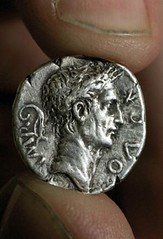
PREV ARTICLE
NEXT ARTICLE
FULL ISSUE
PREV FULL ISSUE
METAL DETECTORIST FINDS UNUSUAL COUNTERFEIT ROMAN COIN
David Sundman and Arthur Shippee forwarded this story about an unusual Roman coin find. Thanks!
-Editor
Experts say the coin is a mystery because it is made from solid silver and probably cost the forger as much to make as he received in profit. The British Museum has never seen anything like it and its rarity has pushed up its value from £100 for a genuine coin to at least £3,000. The silver denarius is based on coins struck to commemorate the Battle of Actium between Octavian and the combined forces of Mark Antony and Cleopatra in 31BC. But experts have revealed that the forger got most of his inscriptions wrong. He crafted his denarius some years after the battle but had a poor memory of what the real coin looked like, it has been claimed. On one side is a crocodile but it is facing the wrong way and on the other side is the head of Emperor Caesar when it should have been Augustus. The forger made a further mistake by mis-spelling Egypt. He inscribed Aegipto instead of the common spelling of the time, Aegypto or Aegvpto. Sam Moorhead, national finds adviser for ancient coins at the British Museum, said the poor spelling "suggests the die cutter is not fully literate". He said: "Interpreting the coin is difficult. Were it a (silver) plated piece, then it would have been explicable as an attempt to create a coin for profit by using a smaller amount of silver. "However, why would someone create a fantasy piece like this in the ancient period from solid silver? As such, the coin is a mystery." Mr Clements, who lives in Brighton, said: "I never thought I'd find anything so interesting and valuable and so soon after getting a detector. "I would have been thrilled finding a genuine coin but this fake could mean a big difference to my life. I've always loved history but never bothered much at school. "Now I'm seriously looking into the idea of selling the coin and putting it towards a degree here at the university. "I hope to study more about the Romans. It's fascinating that there were forgers at the time, some, it seems, who were not very bright.
So what's a "Del Boy"? How are early counterfeits like these catalogued in the literature?
-Editor
Stuart Williams of Ireland adds (on Flickr): An X-ray fluorescence test should settle the question if it's a contemporary or a later copy. The test is non-destructive and one of the least expensive metallurgical investigative techniques for analysis of elements and isotopes. I'd be suprised if the British Museum did not request a test on this interesting coin. There is a well equiped engineering department in the nearby University of London.
To read the complete article, see:
Brighton cleaner finds "Del Boy" Roman coin with first metal detector
(www.theargus.co.uk/news/8491675.Brighton_cleaner The Numismatic Bibliomania Society is a non-profit organization promoting numismatic literature. See our web site at coinbooks.org. To submit items for publication in The E-Sylum, write to the Editor at this address: whomren@gmail.com To subscribe go to: https://my.binhost.com/lists/listinfo/esylum All Rights Reserved. NBS Home Page Contact the NBS webmaster 
|
